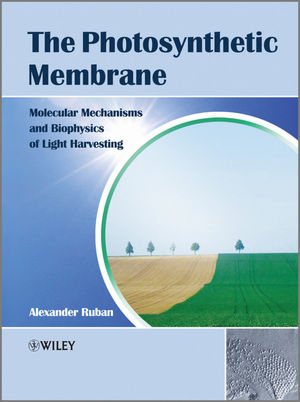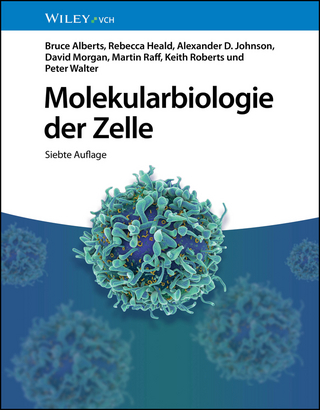
The Photosynthetic Membrane
John Wiley & Sons Inc (Verlag)
978-1-119-96054-6 (ISBN)
- Titel ist leider vergriffen;
keine Neuauflage - Artikel merken
Professor Alexander V. Ruban, School of Biological and Chemical Sciences, Queen Mary University of London, UK. Professor Ruban is a Professor in Biophysics at Queen Mary University of London and holds a 'Professeur des Universites (Biochimie et biologie moleculaire)' title awarded by the French Ministry of Education. He obtained his PhD at the Institute of Plant Physiology at the Academy of Sciences of the Ukraine. His research has been instrumental in the discovery of the molecular basis of photoprotection in LHCII and the in vivo configuration and dynamics of higher plant xanthophylls in the thylakoid membrane. The Ruban Lab at Queen Mary is engaged in mechanistic photosynthesis research with a multidisciplinary approach applies molecular spectroscopy, biophysics and biochemistry to important problems in plant physiology, specifically, the role of the various components (proteins, lipids, pigments) and macrostructure in the functions and adaptive mechanisms of the photosynthetic membrane related to light harvesting and photoprotection in plants and algae. In addition, professor Ruban is interested in the universal properties of carotenoids in biological membranes, the molecular dynamics of these molecules in the modulation of membrane protein conformation and their functions.
Preface xi Acknowledgements xiii 1 Life, Energy and Light 1 1.1 The Definition of Life 1 1.2 The Energy of Matter 2 1.2.1 The Source of Life s Energy 1.3 Energy for the Future 3 1.4 Photosynthesis by Life 4 1.4.1 Photon Energy Transformations 5 Reference 6 Bibliography 6 2 The Space of the Cell 7 2.1 The Cell Concept: Fundamental Nature Of Life 7 2.2 Compartmentalization: The Cult of the Membrane 9 2.3 Membrane Components: Fundamentals of Proteins 12 2.4 Functional Classification of Membrane Proteins 14 Reference 15 Bibliography 16 3 The Photosynthetic Membrane: Outlook 17 3.1 Knowledge of the Pre-Atomic Structure Era: Organization of the Photosynthetic Membrane System 17 3.2 Composition of the Photosynthetic Membrane 21 3.2.1 Lipids 21 3.2.2 Lipid-Related Compounds of the Photosynthetic Membrane 22 3.2.3 Proteins and Protein Complexes 25 3.3 Oligomerization, Interactions and Mobility of the Photosynthetic Proteins: Enabling Functions and Adaptations 28 3.3.1 Oligomerization and Clustering of Photosynthetic Membrane Proteins 28 3.3.2 Protein Mobility 29 Reference 31 Bibliography 31 4 Popular Methods and Approaches to Study Composition, Structure and Functions of the Photosynthetic Membrane 33 4.1 Biochemistry and Molecular Biology Approaches 33 4.1.1 Isolation of Chloroplasts and Subchloroplast Particles 33 4.1.2 Isolation of Membrane Protein Complexes 35 4.1.3 Analysis of Lipids and Pigments 37 4.1.4 Protein Expression and Reconstitution In Vitro 38 4.1.5 Reconstitution of Membrane Proteins in Liposomes 39 4.1.6 Mutagenesis and Transgenic Manipulations 39 4.2 Visualization Techniques 40 4.2.1 Optical Microscopy 40 4.2.2 Electron Microscopy (EM) 42 4.2.3 Atomic Force Microscopy (AFM) 45 4.2.4 Crystallography Methods 46 4.3 Function Probing Methods 47 4.3.1 Absorption-Based Approaches 48 4.3.2 Raman Spectroscopy 53 4.3.3 Fluorescence-Based Approaches 54 References 64 Bibliography 64 5 Primary Processes of the Light Phase of Photosynthesis: Principles of Light Harvesting in Antennae 65 5.1 The Nature of Light 65 5.2 Absorption of Light by Molecules 69 5.3 Fate of Absorbed Light Energy 70 5.4 The Need for the Photosynthetic Antenna and the Fifth Fate of Excitation Energy 73 5.5 Photosynthetic Antenna Pigments 79 5.5.1 Chlorophylls 79 5.5.2 Xanthophylls 85 5.6 Variety and Classification of Photosynthetic Antennae 88 5.7 Principles of Light Harvesting: Summary 89 5.8 Connecting Light Harvesting Antenna to the Photosystems: Red Energy Traps 93 References 95 Bibliography 96 6 Towards the Atomic Resolution Structure of Light Harvesting Antennae: On the Path of Discoveries 97 6.1 Discovery and Primary Characterization of the Higher Plant Antenna Complex 98 6.2 Development of Isolation Methods: Intactness, Purity and Quantity 100 6.3 LHCII Crystallography: The Beginnings 103 6.4 Revealing the Atomic Resolution Structure of LHCII Antenna Complexes 107 6.4.1 Key Biochemical and Spectroscopic Advances that Aided the Emergence of the Current Atomic LHCIIb Structure 107 6.4.2 The New Structure of LHCIIb 110 6.5 Structure of a Minor LHCII Complex CP29 121 6.6 Comparison of LHCII Structure with the Structure of a Simpler Light Harvesting Complex from Purple Bacteria, LH2 123 References 127 Bibliography 127 7 Structural Integration of Antennae within Photosystems 129 7.1 Light Harvesting Complexes Gene Family 130 7.2 Toward the Structure of a Complete Photosystem II Unit: Supercomplexes 131 7.3 Supramolecular Structure of Photosystem I: LHCI 139 7.4 Photosynthetic Membrane Protein Landscapes 140 7.5 Robustness of the Light Harvesting Antenna Design: Resurrecting the Structure to Preserve the Function 143 References 149 Bibliography 150 8 Dynamics of Light Harvesting Antenna: Spectroscopic Insights 151 8.1 Steady-State Optical Spectroscopy of LHCII: Composition and Order 152 8.2 Time-Resolved Spectroscopy of LHCII: Energy Migration 156 8.2.1 Time-Resolved Fluorescence Spectroscopy 156 8.2.2 Time-Resolved Absorption Spectroscopy 160 8.3 Spectral and Structural Identity of LHCII Xanthophylls 161 8.4 Plasticity of Light Harvesting Antenna Design: Tailoring the Structure to Optimize the Function 167 8.5 LHCII Oligomerization : Dynamics of the Programmed Solvent 170 8.5.1 Alterations in the Spectral Properties of LHCII 170 8.5.2 Structural Changes within LHCII 174 8.6 Kinetics of the Collective LHCII Transition into the Dissipative State: Exploring The Switch Control 180 References 184 Bibliography 185 9 Adaptations of the Photosynthetic Membrane to Light 187 9.1 The Need for Light Adaptations and their Various Strategies 188 9.2 Long-Term Regulation of the Photosystem Ratio and their Antenna Size: Acclimation 191 9.3 Short-Term Adaptations to Light Quality: State Transitions 192 9.3.1 The Phenomenology of State Transitions 192 9.3.2 The Molecular Mechanism of State Transitions 195 9.3.3 Chromatic Adaptations in Plants Lacking the Polypeptides of the Major LHC II Complex 199 9.3.4 Future of State Transitions Research 201 9.4 Short-Term Adaptations to Light Quantity 203 9.4.1 Control of Excess Light Energy in Photosystem II The Phenomenon of Nonphotochemical Chlorophyll Fluorescence Quenching (NPQ) 203 9.4.2 The Molecular Components and Processes Involved in NPQ 206 9.4.3 Future of qE Research 225 References 226 Bibliography 226 10 What is in it for Plant, Biosphere and Mankind? 229 10.1 Science and Society 229 10.2 Energy Balance of Photosynthesis: A Wasteful Process? 230 10.3 Crops and Light Harvesting 234 10.4 Light Harvesting Principles for Future Applications: Liberation from Saturation Constraints 237 10.5 Effects of Changing Climate The Onset of Disorder 240 Bibliography 242 11 Conclusions 243 Index
| Erscheint lt. Verlag | 28.11.2012 |
|---|---|
| Verlagsort | New York |
| Sprache | englisch |
| Maße | 176 x 252 mm |
| Gewicht | 622 g |
| Themenwelt | Naturwissenschaften ► Biologie ► Biochemie |
| Naturwissenschaften ► Chemie ► Organische Chemie | |
| Naturwissenschaften ► Physik / Astronomie ► Angewandte Physik | |
| ISBN-10 | 1-119-96054-1 / 1119960541 |
| ISBN-13 | 978-1-119-96054-6 / 9781119960546 |
| Zustand | Neuware |
| Haben Sie eine Frage zum Produkt? |
aus dem Bereich


